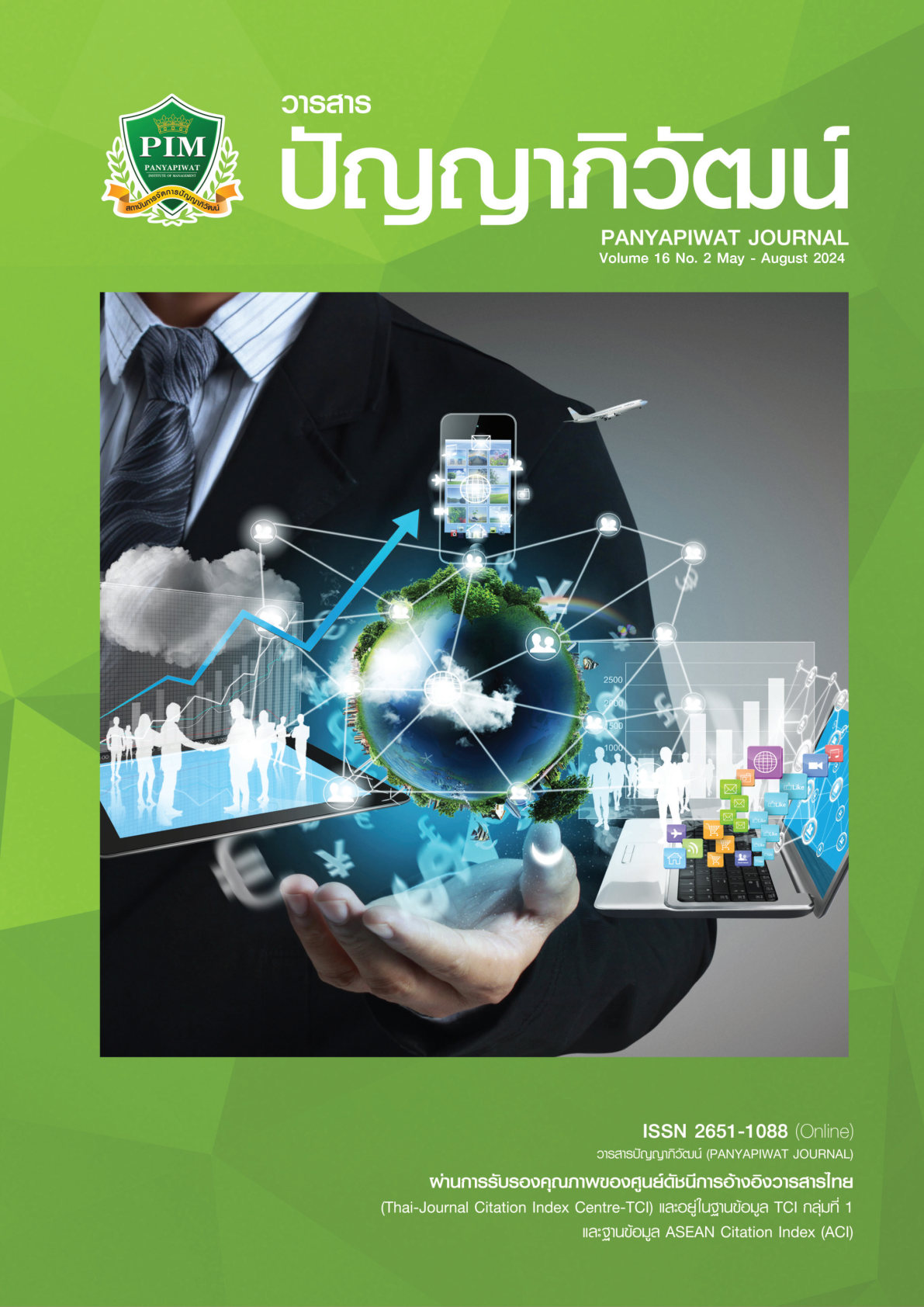การวิเคราะห์ปัจจัยความแออัดของจุดรอสัญญาณไฟจราจรในวงเวียนอนุสาวรีย์ชัยสมรภูมิ
Main Article Content
บทคัดย่อ
งานวิจัยนี้มีวัตถุประสงค์เพื่อ 1) วิเคราะห์ปัจจัยที่ส่งผลกระทบให้เกิดความแออัดภายในวงเวียนและ 2) เพื่อกำหนดแนวทางการแก้ปัญหาการจราจรติดขัดจากปัจจัยความแออัด เครื่องมือที่ใช้ในการวิจัยคือ 1) การวิเคราะห์ความแปรปรวนของปัจจัย (ANOVA) ด้วยโปรแกรม XLSTAT และ 2) การพัฒนาแบบจำลองสภาพการจราจรระดับจุลภาคด้วยโปรแกรม Simulation of Urban MObility โดยการใช้ฐานข้อมูลจากโปรแกรมภูมิศาสตร์สารสนเทศ QGIS โดยตั้งข้อสมมติฐานว่าระยะเวลารอคอยเฉลี่ยและความยาวแถวคอยเฉลี่ยของยานพาหนะไม่แตกต่างกันของทุกกลุ่มที่ทำการทดสอบจำ นวน 5 กลุ่มตามปัจจัยที่กำหนด
ผลการศึกษาพบว่า ปัจจัยที่ส่งผลกระทบต่อความแออัดของระบบการจราจร ได้แก่ ระยะเวลาสัญญาณไฟจราจร ปัจจัยจำนวนช่องจราจรและปัจจัยการกำ หนดทิศทางของช่องจราจร ทั้งในช่วงเวลาเร่งด่วนและ นอกช่วงเวลาเร่งด่วน แนวทางการแก้ปัญหาการจราจรติดขัดโดยการปรับเปลี่ยนรูปแบบสัญญาณไฟจราจรพบว่า วิธีการ Queue Storage Capacity ได้ผลลัพธ์ดีที่สุด ดังนี้ 1) ระยะเวลารอคอยเฉลี่ยลดลง 1.58 วินาที/คัน หรือลดลงร้อยละ 0.74 และ 2) ความยาวเฉลี่ยแถวคอยลดลง 0.84 คัน หรือลดลงร้อยละ 4.57 สำ หรับนอกช่วงเวลาเร่งด่วน ดังนี้ 1) ระยะเวลารอคอยเฉลี่ยลดลง 1.57 วินาที/คัน หรือลดลงร้อยละ 1.41 และ 2) ความยาวเฉลี่ยแถวคอยลดลง 1.77 คันหรือลดลงร้อยละ 15.02
Article Details

อนุญาตภายใต้เงื่อนไข Creative Commons Attribution-NonCommercial-NoDerivatives 4.0 International License.
“ข้าพเจ้าและผู้เขียนร่วม (ถ้ามี) ขอรับรองว่า บทความที่เสนอมานี้ยังไม่เคยได้รับการตีพิมพ์และไม่ได้อยู่ระหว่างกระบวนการพิจารณาลงตีพิมพ์ในวารสารหรือแหล่งเผยแพร่อื่นใด ข้าพเจ้าและผู้เขียนร่วมยอมรับหลักเกณฑ์การพิจารณาต้นฉบับ ทั้งยินยอมให้กองบรรณาธิการมีสิทธิ์พิจารณาและตรวจแก้ต้นฉบับได้ตามที่เห็นสมควร พร้อมนี้ขอมอบลิขสิทธิ์บทความที่ได้รับการตีพิมพ์ให้แก่สถาบันการจัดการปัญญาภิวัฒน์หากมีการฟ้องร้องเรื่องการละเมิดลิขสิทธิ์เกี่ยวกับภาพ กราฟ ข้อความส่วนใดส่วนหนึ่งและ/หรือข้อคิดเห็นที่ปรากฏในบทความข้าพเจ้าและผู้เขียนร่วมยินยอมรับผิดชอบแต่เพียงฝ่ายเดียว”
เอกสารอ้างอิง
Archana, N., Manish, C., & Sanjay, S. (2022). An empirical study on parameters affecting traffic stream variables under rainy conditions. In The Proceedings of the 14th International Conference on Communication Systems & NETworkS (COMSNETS). (pp. 818-823). IEEE.
Behrisch, M., Bieker-Walz, L., Erdmann, J., & Krajzewicz, D. (2011). Sumo–simulation of urban mobility: An overview. In The Proceedings of the Third International Conference on Advances in System Simulation (pp. 63-68). Research Gate.
Chawitra, T. (2011). Roadside stand market at Victory Monument, Bangkok. Journal of Behavioral Science for Development, 3(1), 28-42. [in Thai]
Gracia, M. D., González-Ramírez, R. G., & Mar-Ortiz, J. (2017). The impact of lanes segmentation and booking levels on a container terminal gate congestion. Flexible Services and Manufacturing Journal, 29, 403-432.
Indee, T. (2021). Analyzing a mixed toll collection system using traffic microsimulation models: A case study of Din Daeng Toll Plaza. Ladkrabang Engineering Journal, 38(1), 1-14. [in Thai]
Islam, S. (2018). Simulation of truck arrival process at a seaport: Evaluating truck-sharing benefits for empty trips reduction. International Journal of Logistics Research and Applications, 21(1), 94-112.
Kamollimsakul, W., & Pitaksringkarn, J. (2018). Traffic operational analysis of continuous flow urban interchange using micro simulation modeling technique: A case study of Dat Daruni School, Chachoengsao. Ladkrabang Engineering Journal, 35(1), 23-32. [in Thai]
Kantanon, V. (2018). Determining the use of coordinated signal control case study: Intersection network on Mahidol Road, Chiang Mai Province [Master’s thesis]. Thammasat University. [in Thai]
Keereewong, S., Satiennam, T., Satiennam, W., & Kronprasert, N. (2018). A study of Black Bpot Improvement at Intersections of Engineering Faculty, Khon Kaen University by applying microscopic traffic Simulation. KKU Research Journal (Graduate Studies), 19(1), 88-100. [in Thai]
Nopphonkrang, C., Kumphan, T., Tosing, N., Soyphet, S., & Rattaphan, S. (2021). A study feasibility for traffic control at intersection: A case study at Sipruetthalai Rajabhat Seminar Hall, Muang District Sisaket Province. Science and Technology Journal of Sisaket Rajabhat University, 1(2), 53-61. [in Thai]
Office of Transport and Traffic Policy and Planning. (2022). Traffic volume at intersections in Bangkok in 2021. https://data.bangkok.go.th/dataset/traffic_volume
Seksan, J., Anurak, S., Choosombat, C., Kumkrut, T., & Wongsuthep, S. (2021). The application of simulation technique in traffic lights timing for reducing the waiting time at Thakub Intersection, Muang District, Surat Thani Province. Thai Industrial Engineering Network Journal, 7(1), 15-22. [in Thai]
Suanchan, L., & Pitaksringkarn, J. (2019). A study of traffic signal coordination system: A case study of the Royal Initiate Project Road of His Majesty King RAMA IX. Engineering Journal of Research and Development, 31(1), 73-85. [in Thai]
Surachodkriangkrai, N., & Karoonsoontawong, A. (2015). Roundabout metering signal design: A case study of democracy monument roundabout. Panyapiwat Journal, 7(1), 194-206. [in Thai]
Wang, J., Huynh, N. N., & Pena, E. (2022). Land side truck traffic modeling at container terminals by a stationary two-class queuing strategy with switching. Journal of International Logistics and Trade, 20(3), 118-134.
Wichaimethawee, T. (2002). Development of traffic signal control strategies for saturated traffic conditions [Master’s thesis]. Chulalongkorn University. [in Thai]
Yaibok, C., & Luathep, P. (2015). An analysis of traffic management of multiple consecutive intersections: A case study of Hat Yai Municipality. UBU Engineering Journal, 8(1), 103-114. [in Thai]


